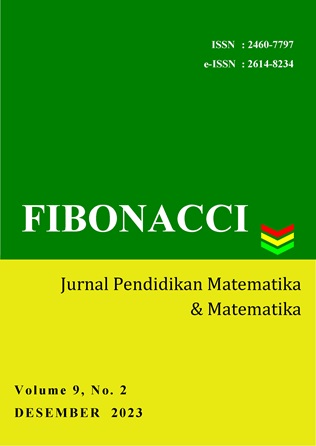HYPOTHETICAL LEARNING TRAJECTORY MATERI ARITMATIKA SOSIAL BERBANTUAN VIDEO INTERAKTIF: KONTEKS JUAL BELI DI MAL
DOI:
https://doi.org/10.24853/fbc.9.2.219-228Keywords:
Design research, HLT, aritmatika sosial, PMRI, Jual beli di malAbstract
Aritmatika sosial merupakan materi yang sangat penting dikuasai oleh siswa, namun siswa masih kesulitan dalam menguasai dan memahami materi tersebut. Kesulitan tersebut dapat menghambat siswa menuju langkah selanjutnya yaitu penyelesaian soal. Oleh karena itu dibutuhkan pendesainan pembelajaran menggunakan pendekatan dan media inovatif, salah satunya menggunakan PMRI. Metode penelitian yang digunakan dalam penelitian ini adalah adalah design research yang terdiri dari tiga tahapan yaitu: preliminary design, design experiment, retrospective analysis. Penelitian ini merumuskan Hypothetical Learning Trajectory (HLT) dalam tiga aktivitas yaitu: (1) aktivitas menemukan konsep persentase dan menyelesaikan permasalahan kontekstual yang ada di dalamnya; (2) aktivitas menemukan konsep untung rugi serta persentasenya dan menyelesaikan permasalahan kontekstual yang ada di dalamnya; (3) aktivitas menemukan konsep bruto, netto, tara beserta persentasenya dan menyelesaikan permasalahan kontekstual aritmatika sosial. Rancangan tersebut diharapkan dapat memfasilitasi siswa dalam pembelajaran, sehingga siswa dapat memahami konsep dan memecahkan masalah matematis dalam materi aritmatika sosial.References
A Agustina, R. (2018) Analisis Penyebab Konsumen Lebih Memilih Berbelanja Di Pasar Tradisional Di Bandingkan Pasar Moder. skripsi. jurusan ekonomi syari’ah insritut agama islam negeri metro, Skripsi, p. 92. Available at: https://repository.metrouniv.ac.id/id/eprint/1869.
Anggraeni, R. and Fitrianna, A.Y. (2021). Soal Aritmatika Sosial Selama Pandemi Covid-19, 4(5), pp. 1269–1278. doi:10.22460/jpmi.v4i5.1269-1278.
Bakker, A. (2004). In Design Research in Statis- tics Education. On Symbolizing and Com- puterTools. Amersfoort: Wilco Press.
Fahrurozi, A. et al. (2018). Developing Learning Trajectory Based Instruction of the Congruence for Ninth Grade Using Central Java Historical Building, JRAMathEdu (Journal of Research and Advances in Mathematics Education), 3(2), p. 78. doi:10.23917/jramathedu.v3i2.6616.
Fitriyana, E.V. and Nursyahidah, F. (2022). Desain Pembelajaran Limas Berkonteks Atap Masjid Agung Jawa Tengah Berbantuan Video, AKSIOMA: Jurnal Program Studi Pendidikan Matematika, 11(2), p. 1423. doi:10.24127/ajpm.v11i2.4272.
Gravemeijer, K. & Cobb, P. (2006). Design research from a Learning Design Perspective. In (Eds) van den Akker, J., Gravemeijer, K., McKenney, S., & Nieveen, N., Educational design research (h. 17-51). New York: Routledge. https://doi.org/10.4324/9780203088364
Gravemeijer, K., & van Eerde, D. (2009). Design research as a means for building a knowledge base for teachers and teaching in mathematics education. The elementary school journal, 109(5), 510-524. https://www.journals.uchicago.edu/doi/full/10.1086/596999
Kemendikbud. 2022. Keputusan Kepala BSKAP Tentang Capaian Pembelajaran. https://kurikulum.kemdikbud.go.id/wp-content/unduhan/CP_2022.pdf
Khan, S.B.S. and Salman, R. (2020). Influence of mathematics in our daily lives, Arts & Humanities Open Access Journal, 4(2), pp. 50–52. doi:10.15406/ahoaj.2020.04.00152.
Lestariningsih. (2010). Desain Pem- belajaran Matematika Legenda Pulau Kemaro pada Pem- belajaran Statistika di Kelas VI Sekolah Dasar. Prosiding Seminar Nasional Pendidikan 2012. pp 215-224.
Li, C. (2022). Foreign language learning boredom and enjoyment: The effects of learner variables and teacher variables. Language Teaching Research, 13621688221090324.
Lisnani, L. (2019). Pemahaman Konsep Awal Calon Guru Sekolah Dasar Tentang Pecahan. Mosharafa: Jurnal Pendidikan Matematika, 8(1), 61-70.
Nursyahidah, F., Putri, R. I. I., & Somakim. (2013). Supporting first grade students’ understanding of addition up to 20 using traditional game. Journal on Mathematics Education, 4(2), 212–223. https://doi.org/10.22342/jme.4.2.557.212-223
Nursyahidah, F., Putri, R. I. I., & Somakim. (2014). Instructional Design of Subtraction Using PMRI Approach Based On Traditional Game. 978, 132–141.
Nursyahidah, F., Saputro, B. A., & Rubowo, M. R. (2018). Supporting second grade lower secondary school students understanding of linear equation system in two variables using ethnomathematics. Journal of Physics: Conference Series, 983(1). https://doi.org/10.1088/1742-6596/983/1/012119
Nursyahidah, F., & Albab, I. U. (2021). Learning Design on Surface Area and Volume of Cylinder Using Indonesian Ethno-mathematics of Traditional Cookie maker Assisted by GeoGebra. Mathematics Teaching Research Journal,13(4), 79-98.
Paramitha, N. and Yunianta, T.N.H. (2017) Analisis Proses Berpikir Kreatif dalam Memecahkan Masalah Matematika Materi Aritmatika Sosial Siswa SMP Berkemampuan Tinggi, Jurnal Mitra Pendidikan (JMP Online), 1(10), pp. 983–994. Available at: http://e-jurnalmitrapendidikan.com.
Putri, R. I. I., & Zulkardi. (2017). Fraction in shot-put: A learning trajectory. AIP Conference Proceedings, 1868(August 2017). https://doi.org/10.1063/1.4995132
Rahman, Z.H. and Setyaningsih, R. (2020). Meningkatkan Kemampuan Pemecahan Masalah Siswa Melalui Pendekatan Realistic Mathematics Education, Suparyanto dan Rosad (2015, 5(3), pp. 248–253.
Risnawati (2013). Pengaruh Pendekatan Realisitic Mathematics Education Dengan Mind Mapping Terhadap Kemampuan Berpikir Kritis Dengan Self-Efficacy Mahasiswa, 6(1), pp. 37–45.
Sapitri, Y., Fitriani, N., & Kadarisma, G. (2020). Analisis kesulitan siswa smp dalam menyelesaikan soal pada materi aritmetika sosial. JPMI: Jurnal Pembelajaran Matematika Inovatif, 3(5), 567–574. https://doi.org/10.22460/jpmi.v3i5.567-574
Sembiring, R., Hoogland, K., & Dolk, M. (2010). A_decade_of_PMRI_in_Indonesia_red_Sembiring_Hoogland_Dolk.pdf.
Sitompul, S.H. (2022). Pengembangan Lintasan Belajar Siswa Dalam Pembelajaran Segitiga Dengan Menggunakan Pendekatan Kontekstual Di Kelas Vii Mtsn 2 Padangsidimpuan, 06(01), pp. 17–35.
Simonson. (2006). Design-Based Research, Aplications for Distance Education. The Quarterly Review of Distance Education, Volume 7(1): vii-viii Tim Pustaka Jawatimuran
Surya, A., Zulkardi, Z., & Somakim, S. (2017). Desain Pembelajaran Statistika Menggunakan Konteks Mal di Kelas V. Jurnal Elemen, 3(2),149. https://doi.org/10.29408/jel.v3i2.3 44
Treffers, A. (1991). Didactical background of a mathematics program for primary education, in L. Streefland (Ed.), Realistic Mathematics Education in Primary School: On the Occasion of the Opening of the Freudenthal Institute, (pp. 21-56). Utrecht: CD-?? Press, Center for Science and Mathematics Education, Freudenthal Institute, Research Group on Mathematics Education, Utrecht University.
Uszyńska-Jarmoc, J. and Kunat, B. (2020) Students and Teachers Implicit and Explicit Theories of Creativity, Creativity, 6(2), pp. 223–249. doi:10.1515/ctra-2019-0013.
Downloads
Published
Issue
Section
License
Authors who publish with this journal agree to the following terms:
- Authors retain copyright and grant the journal right of first publication with the work simultaneously licensed under a Creative Commons Attribution License that allows others to share the work with an acknowledgement of the work's authorship and initial publication in this journal.
- Authors are able to enter into separate, additional contractual arrangements for the non-exclusive distribution of the journal's published version of the work (e.g., post it to an institutional repository or publish it in a book), with an acknowledgement of its initial publication in this journal.
- Authors are permitted and encouraged to post their work online (e.g., in institutional repositories or on their website) prior to and during the submission process, as it can lead to productive exchanges, as well as earlier and greater citation of published work (See The Effect of Open Access).


